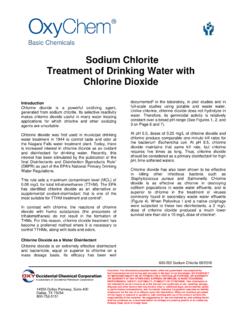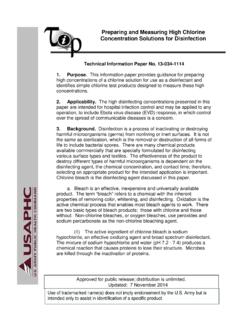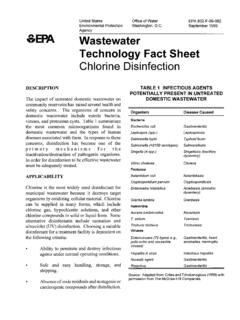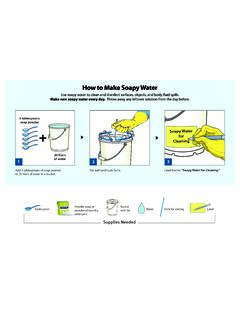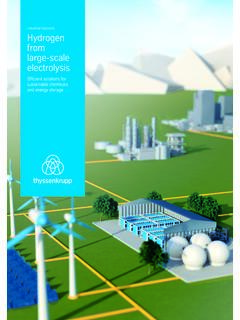Transcription of WHO | Water quality guidelines
1 2004 World Health Organization. Water Treatment and Pathogen Control: Process Efficiency in Achieving Safe Drinking Water . Edited by Mark W LeChevallier and Kwok-Keung Au. ISBN: 1 84339 069 8. Published by IWA Publishing, London, UK. 3 Inactivation (disinfection) processes This chapter covers the various disinfection processes used in drinking- Water treatment to inactivate pathogenic microbes. It looks first at factors affecting the efficiency of disinfection process, and then goes on to consider the following disinfection processes: pretreatment oxidation in which oxidants are added to Water early in the treatment process. primary disinfection a common component of primary treatment of drinking- Water , and important because granular filter media do not remove all microbial pathogens from Water secondary disinfection used to maintain the Water quality achieved at the treatment plant throughout the distribution system up to the tap.
2 FACTORS AFFECTING DISINFECTION The principal factors that influence disinfection efficiency are disinfectant concentration, contact time, temperature and pH. Disinfectant concentration and 42 Water treatment and pathogen control contact time are integral to disinfection kinetics and the practical application of the CT concept (CT being the disinfectant concentration multiplied by the contact time). Development and derivations of this disinfection model are discussed in the modelling section below. Temperature, over the range appropriate for drinking- Water , affects the rate of disinfection reactions according to the Arrhenius equation, although this may not hold for certain disinfectants at low temperatures. The pH of the disinfectant solution affects the reaction kinetics. For example, the disinfection efficiency of free chlorine is increased at lower pH values, whereas that of chlorine dioxide is greater at alkaline pH levels.
3 Monochloramine is formed within seconds in the pH range 7 9, at chlorine to ammonia nitrogen ratios of less than 5:1 and at 25 C; it is also the predominant species when the pH is greater than 5. Other factors that influence microbial sensitivity to disinfection include attachment to surfaces, encapsulation, aggregation and low-nutrient growth. Increased resistance to disinfection may result from attachment or association of microorganisms to various particulate surfaces, including: macroinvertebrates (Crustacea, Nematoda, Platyhelminthes and Insecta)(Tracy, Camarena & Wing, 1966; Levy, Cheetham & Hart, 1984); particles that cause turbidity (LeChevallier, Evans & Seidler, 1981; Ridgway & Olson, 1982); algae (Silverman, Nagy & Olson, 1983); carbon fines (LeChevallier et al., 1984; Camper et al., 1986); glass (Olivieri et al., 1985). Ridgway & Olson (1982) showed that the majority of viable bacteria in chlorinated Water were attached to particles.
4 Stewart & Olson (1986) reported that aggregation of Acinetobacter strain EB22 increased its resistance to disinfection, making the bacteria 100-fold more resistant to hypochlorous acid (HOCl) and more resistant to monochloramine. Several investigators have isolated encapsulated bacteria from chlorinated Water (Reilly & Kippin, 1983; Clark, 1984) and concluded that production of the extracellular capsule helped protect bacteria from chlorine . Carson et al. (1972) reported that Pseudomonas aeruginosa grown in distilled Water was markedly more resistant to acetic acid, glutaraldehyde, chlorine dioxide and a quaternary ammonium compound than cells cultured on tryptic soy agar. Similarly, Berg, Matin & Roberts (1981) and Harakeh et al. (1985) found that bacteria grown in a chemostat at low temperatures and submaximal growth rates caused by nutrient limitation (conditions thought to be similar to the natural aquatic environment) were resistant to several disinfectants.
5 Inactivation (disinfection) processes 43 PRETREATMENT OXIDATION Water utilities often add oxidants early in the treatment process to: maximize the contact time with the oxidant; oxidize compounds for subsequent removal by the treatment process ( iron or manganese); provide initial treatment in sufficient time for Water to be further treated if necessary ( oxidation of taste and odour compounds); control growth of microorganisms and higher organisms ( zebra mussels) on intake structures and in treatment basins; improve particle removal in subsequent clarification and filtration processes. There are a number of potential problems with pretreatment oxidation. Variable source Water conditions mean that variable or high levels of oxidant may be needed. This may lead to overdosing of pre-oxidants, which can result in pink coloured Water when potassium permanganate is misapplied.
6 Also, the process can produce oxidation by-products such as trihalomethanes (THMs), haloacetic acids and bromate. For example, in using chlorine as a pretreatment oxidant, chlorinated by-products can form rapidly. This often limits the application of chlorine to a later stage of the treatment process, when precursor material has been removed. A further problem is that oxidants can lyse algal cells, releasing liver or nerve toxins, or creating objectionable tastes or odours. (Yoo et al., 1995b; Chorus & Bartram, 1999). One concern with using pre-oxidants for disinfection is that particulate material may interfere with microbial inactivation. Such material protects bacteria and viruses from disinfectants by creating an instantaneous disinfectant demand (preventing the maintenance of a disinfectant residual in subsequent treatment steps) and by shielding the microbe from the oxidant (Hoff, 1978; LeChevallier, Evans & Seidler, 1981; Berman, Rice & Hoff, 1988).
7 The effect of particulate material on disinfection of cysts or oocysts has not been widely evaluated. Di Giovanni & LeChevallier (2000) studied the effect of turbidity on disinfection of Cryptosporidium parvum oocysts by chlorine dioxide or permanganate, and found that particulate material did not interfere with disinfection once the increase in oxidant demand had been satisfied (Figure ). The authors hypothesized that protozoan cysts were too large to be completely shielded from the disinfectant. 44 Water treatment and pathogen control Figure Effect of particulate material on disinfection of Cryptosporidium. Potassium permanganate applied at 2400 mg/min l 1, chlorine dioxide applied at 120 mg/min l : Adapted from Di Giovanni & LeChevallier (2000). PRIMARY DISINFECTION A disinfection barrier is a common component of primary treatment of Water . Primary disinfection is typically a chemical oxidation process, although ultraviolet (UV) irradiation and membrane treatment are gaining increased attention.
8 This section looks at different types of disinfectant chlorine , monochlorine, chlorine dioxide, ozone, UV light and mixed oxidants in terms of their effectiveness against various pathogenic microorganisms. Further information on selecting a disinfection strategy for a piped distribution system can be found in the WHO publication Safe piped Water : Managing microbial Water quality in piped distribution systems (Ainsworth, 2004). chlorine Mode of action chlorine gas and Water react to form HOCl and hydrochloric acid (HCl). In turn, the HOCl dissociates into the hypochlorite ion (OCl ) and the hydrogen ion (H+), according to the following reactions: (1) Cl2 + H2O HOCl + HCl Inactivation (disinfection) processes 45 (2) HOCl H+ + OCl The reactions are reversible and pH dependent: between pH and , HOCl is the predominant species between about pH and , both HOCl and OCl species exist in various proportions above pH 8, OCl predominates.
9 The OCl and HOCl species are commonly referred to as free chlorine , which is extremely reactive with numerous components of the bacterial cell. HOCl can produce oxidation, hydrolysis and deamination reactions with a variety of chemical substrates, and produces physiological lesions that may affect several cellular processes. Baker (1926) theorized that chlorine destroys microorganisms by combining with proteins to form N-chloro compounds. chlorine was later found to have powerful effects on sulfhydryl groups of proteins (Green & Stumpf, 1946, Knox et al., 1948; Venkobachar, Iyengar & Rao, 1977) and to convert several -amino acids by oxidation into a mixture of corresponding nitriles and aldehydes (Patton et al., 1972). The exact product of the reaction depends on chlorine concentration and pH (Dakin 1916, 1917; Wright 1936). Cytochromes, iron-sulfur proteins and nucleotides are highly vulnerable to oxidative degradation by HOCl, suggesting that chlorine causes physiological damage primarily to the bacterial cell membranes (Venkobachar, Iyengar & Rao, 1977; Camper & McFeters, 1979; Haas & Engelbrecht, 1980; Albrich, McCarthy & Hurst, 1981).
10 Respiration, glucose transport and adenosine triphosphate levels all decrease in chlorine -treated bacteria (Venkobachar, Iyengar & Rao, 1977; Camper & McFeters, 1979; Haas & Engelbrecht, 1980). Electron microscopy of chlorinated bacteria has demonstrated morphological changes in the cell membrane (Zaske, Dockins & McFeters, 1980). In addition, chlorination can kill microbes by disrupting metabolism (Wyss, 1961) and protein synthesis (Pereira et al., 1973), or by modifying purine and pyrimidine bases and thus causing genetic defects (Patton et al., 1972; Hoyano et al., 1973; Haas & Engelbrecht, 1980). Nearly 100 years of chlorination for disinfection of drinking- Water has demonstrated the effectiveness of this process for inactivation of microbial pathogens, with the notable exception of of chlorine against bacteria and viruses Table shows CT values for 99% (2-log) inactivation of bacteria for various chlorine -based disinfectants.










